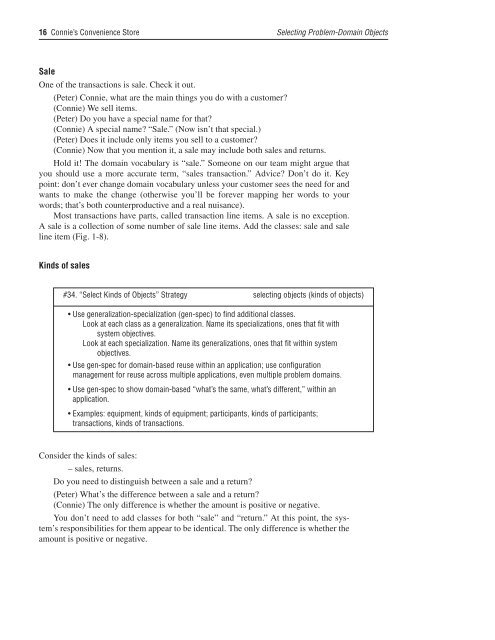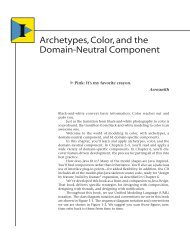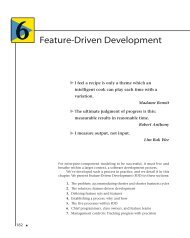Connie's Convenience Store - About Peter Coad
Connie's Convenience Store - About Peter Coad
Connie's Convenience Store - About Peter Coad
Create successful ePaper yourself
Turn your PDF publications into a flip-book with our unique Google optimized e-Paper software.
16 Connie’s <strong>Convenience</strong> <strong>Store</strong> Selecting Problem-Domain Objects<br />
Sale<br />
One of the transactions is sale. Check it out.<br />
(<strong>Peter</strong>) Connie, what are the main things you do with a customer?<br />
(Connie) We sell items.<br />
(<strong>Peter</strong>) Do you have a special name for that?<br />
(Connie) A special name? “Sale.” (Now isn’t that special.)<br />
(<strong>Peter</strong>) Does it include only items you sell to a customer?<br />
(Connie) Now that you mention it, a sale may include both sales and returns.<br />
Hold it! The domain vocabulary is “sale.” Someone on our team might argue that<br />
you should use a more accurate term, “sales transaction.” Advice? Don’t do it. Key<br />
point: don’t ever change domain vocabulary unless your customer sees the need for and<br />
wants to make the change (otherwise you’ll be forever mapping her words to your<br />
words; that’s both counterproductive and a real nuisance).<br />
Most transactions have parts, called transaction line items. A sale is no exception.<br />
A sale is a collection of some number of sale line items. Add the classes: sale and sale<br />
line item (Fig. 1-8).<br />
Kinds of sales<br />
#34. “Select Kinds of Objects” Strategy selecting objects (kinds of objects)<br />
• Use generalization-specialization (gen-spec) to find additional classes.<br />
Look at each class as a generalization. Name its specializations, ones that fit with<br />
system objectives.<br />
Look at each specialization. Name its generalizations, ones that fit within system<br />
objectives.<br />
• Use gen-spec for domain-based reuse within an application; use configuration<br />
management for reuse across multiple applications, even multiple problem domains.<br />
• Use gen-spec to show domain-based “what’s the same, what’s different,” within an<br />
application.<br />
• Examples: equipment, kinds of equipment; participants, kinds of participants;<br />
transactions, kinds of transactions.<br />
Consider the kinds of sales:<br />
– sales, returns.<br />
Do you need to distinguish between a sale and a return?<br />
(<strong>Peter</strong>) What’s the difference between a sale and a return?<br />
(Connie) The only difference is whether the amount is positive or negative.<br />
You don’t need to add classes for both “sale” and “return.” At this point, the system’s<br />
responsibilities for them appear to be identical. The only difference is whether the<br />
amount is positive or negative.




